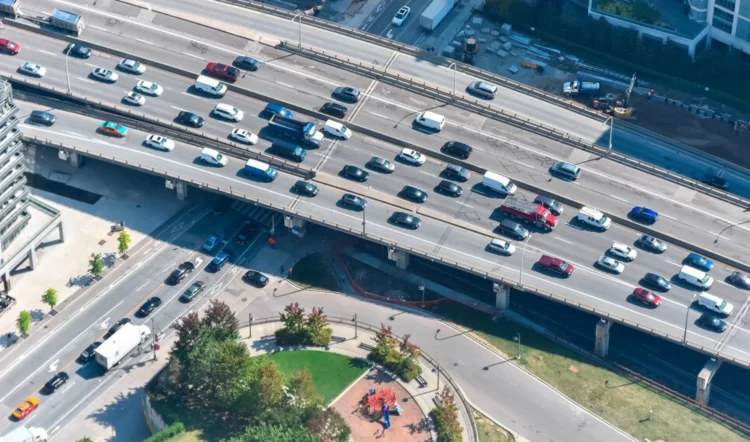Do you want to know what a RoRo ship is? If so, you have come to the right place. RoRo stands for roll-on/roll-off which means a ship designed to carry wheeled cargo: Think cars, vans, trailers, buses, and trucks. Anything that can be ‘rolled’ from the ship.
But there’s quite a bit more to the RoRo ship than that, including some variations on the RoRo theme. In this article we will dive deeper into the world of roll-on/roll-off vessels and find out more about this often overlooked member of the world’s merchant marine fleet.

Everything you need to know about RoRo ships
First of all, you might as well see a RoRo ship called a Ro-Ro ship. It’s the same thing, just a different spelling.
So what makes RoRo different from most other ships used to transport cargo? For starters, container and cargo ships use cranes to load and unload their goods. This crane is usually located in the harbor, although some smaller vessels, such as a feeder ship will have a crane inside. Ships using cranes are known in LoLo ships – lift-on / lift-off.
Obviously, given the nature of its cargo – that of wheeled vehicles – RoRo need not rely on winches: Instead the vehicles it carries can be easily wheeled in and out of the ship via ramps.
In most RoRos, the ramp is located at the stern of the ship. For others, the ramp will be in the bow or the side of the boat. Ramps are also located in harbors for ships that do not have their own built-in ramps.

History of RoRo Ships
RoRo ships first appeared in the 19th century (1801-1900). And with the first motorized vehicle not being patented until 1886 by Carl Benz, it’s clear early RoRo wasn’t used for the hauling of cars and trucks.
What was developed was the transportation of railroad cars and wagons which turned out to be too wide for the bridge that was located on the road to its destination. The obvious choice was to look down the bridge into the river, and thus the RoRo ship was born.
One of the earliest RoRo vessels was the Firth of Forth ferry which began making its trade in Scotland in 1851. Railroad tracks were laid on board the ship in such a way that it could connect to land rails. The chariots were then rolled onto the ship and then rolled over when they had reached their destination. Currently you can book cruise tours around the Firth of Forth.
But did you know that RoRo ships are not just commercial ships? They also had a role to play in the Second World War. It was then that it was realized how valuable the roll-on and roll-off method of transport could be when used in tank landing craft – amphibious vehicles that – as their name suggests – landed tanks on beaches, for example on D-Day and in other engagements.
Shortly thereafter, in the late 1940s, merchant ships began to take advantage of the RoRo principle and became popular on short ferry crossings, especially as cars and other vehicles became increasingly popular.
Fast forward to today, and most of us have, at some point in time, been on a RoRo ship, whether that be as a passenger, a tourist going ‘cruise’ to explore all there is to do on the other side of a river or sea. offer, a commercial truck driver, or even a commuter working on the other side of the water.
RoRo ship type
The benefits of RoRo ships are undeniable, both for passengers and shipping companies, owners or operators. Consider how long it takes to load and unload goods by crane compared to how long it takes for the vehicles to actually drive to the ship, park, and then leave again in port on the other side.
It is therefore no surprise that different iterations of the RoRo vessel have been developed since the early carriage of railcars in Scotland!

Various types of RoRo vessels
A RoRo ship used to transport vehicles as freight comes under the ‘cargo ship’ umbrella however, there is much more to a simple roll-on and roll-off ship than that. As seen, passenger ferries can also be RoRo vessels, just like cruise ships and barges.
These are several types of RoRo vessels:
- PCC – Pure Car Carriers : Specifically used to transport cars.
- PTCC – Pure Truck & Car Transporter: You guessed it – used to transport trucks and cars – as well as other vehicles.
- ConRo – a cross between a container ship and a RoRo ship, these ships typically use the area below the decks for storage of vehicles and the upper decks for stacking shipping containers.
- RoLo – You guys probably guessed this one already – it’s a movable/liftable boat. Ramps are used for loading and unloading wheeled cargo while cranes are used for containerized cargo.
- LMSR – Large Medium Speed Roll-on/Roll-off Vessel. The majority of LMSR ships are Military Sealift Command (MSC) RoRo cargo ships built specifically for military cargo, or converted from commercial RoRo ships.
- RoPax – short for roll-on/roll-off and passenger: It is used for wheeled freight but also has passenger accommodation inside. However if a ship can accommodate more than 500 passengers, it is referred to as a cruise ship, a ship that combines the goods handling capabilities of a RoPax with some of the facilities of a cruise ship.
How is a ship’s RoRo payload measured?
Typically, cargo and container ship loads are measured in metric tons. However it’s not as simple when we talk about RoRo ship cargo as obviously this is not going to be broken down neatly into stackable shipping containers, but will involve a whole medley of vehicles of various sizes, shapes and weights.
Therefore the cargo of RoRo ships is measured in something called Lane in Meters, or LIMs. To calculate it you follow the simple equation below:
The length of the cargo in meters x the width of the cargo in one lane = mystery number
Then
Mystery number x number of decks on board = LIM
However, if you ever come across a situation where you need to calculate the cargo on a RoRo ship, remember that there are a number of different industry standards for lane widths so your final result will depend on the specific ship.
Conclusion
RoRo ships might not be the first ship that comes to mind when you think of cargo ships, but they are the unsung workhorse of the seas!
Thanks to their fast port turnaround times and their versatility in terms of the cargo (and passengers) they can carry, the good old roll-on/roll-off model – and all its variants – show no signs of ending it soon.




Leave a Comment